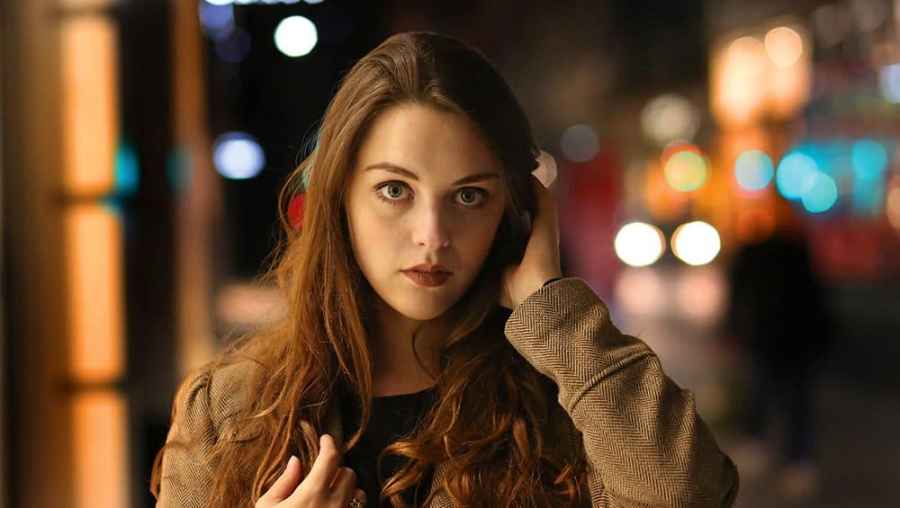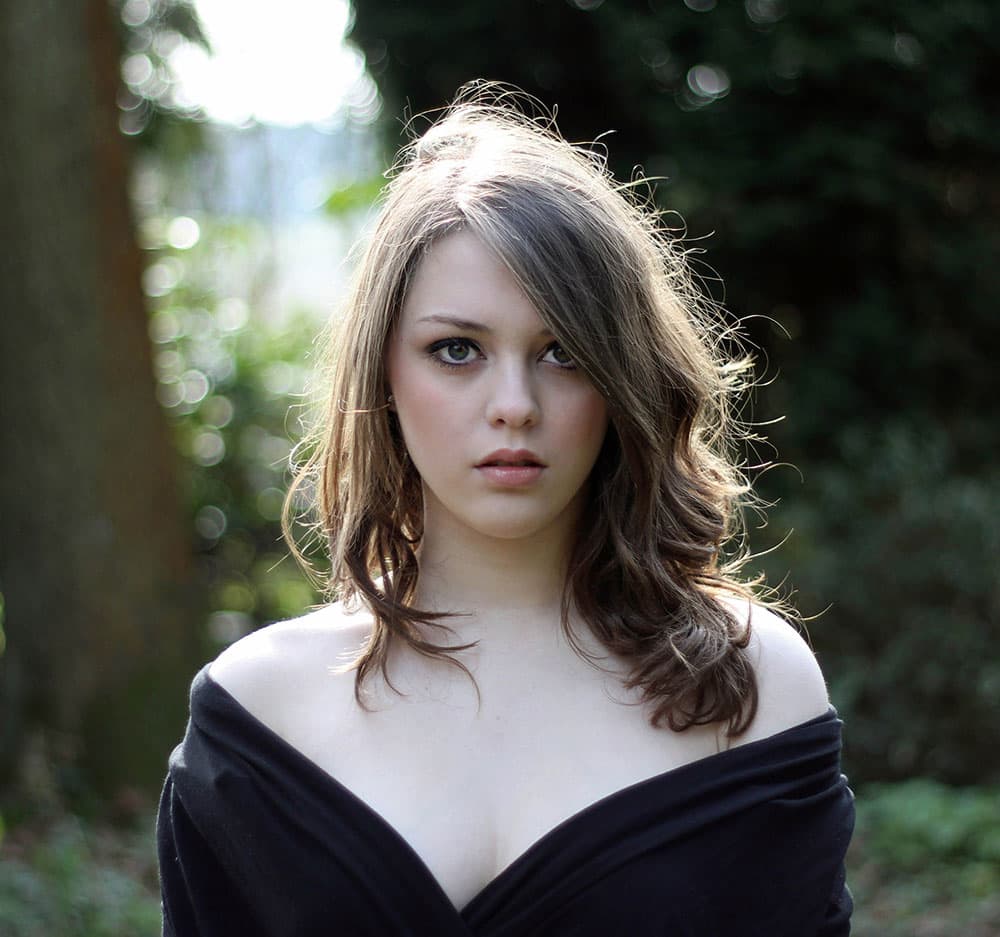
Consider the location, outfit, hairstyle and overall theme for the portrait shoot. Canon EOS 550D, 50mm, 1/320sec at f/1.8, ISO 100. Credit: Mark Wilkinson
Written from the perspective of both photographer and model, One Face, Fifty Ways is an illustrated book that offers an insight into how to expand your skills as a portrait photographer. The book explores camera techniques over a range of portrait scenarios, and provides an insight into how to best communicate with your models and work with them to achieve the best results.
The duo behind the book also created WeeklyImogen, a YouTube channel, that provides photography tutorials on their joint experiences as both a model and photographer as they venture out to different locations. The aim, unusually, is to show the portrait shoot from not only the perspective of the photographer but also that of the model. What also makes Mark’s approach unique is that he works with models over an extended period, following their journey and capturing an aspect of it on film. This is the case with the images captured in this book.
Continues below…
[collection name=”small”]
Mark and Imogen have been working together for seven years and his images aim to provide a visual journey through the period. In terms of themes and style, Mark focuses on creating an image that is realistic and represents something of the personality of the model. He has a life-long love of black & white images and their ability to capture texture, shade and emotion – but he’s also drawn to the colour green, an aspect that features heavily in the colour matching of his images.
For Imogen, on the other side of the lens, she has learned to appreciate how all photographers depict an individual in their own way. As she says, “Each photographer will display their vision of a model in a personal, stylistic way, and it is fascinating to gain an insight into the artistic eye of the photographer, and to visually see yourself presented through the eyes of another.”
Developing human relationships
Photography and the process of working with a model doesn’t only create an image – it’s also a way of developing a human relationship. One Face, Fifty Ways explores the myriad ways to capture an effective portrait and demonstrates some of the techniques employed by Mark and Imogen. It provides practical ideas for photo shoots without the need for expensive equipment. We explore three of Mark and Imogen’s favourite techniques and find out why they are tops when it comes to shooting portraiture.

A leading line can manipulate and guide a viewer’s eye. Canon EOS 550D, 50mm, 1/125sec at f/2.2, ISO 200. Credit: Mark Wilkinson
Lead-in lines
Lead-in lines travel through an image and head toward a distant point in the photograph. By placing a model in the middle or at the end of a lead-in line, the eye will move along it to the focal point of the image. Not only does this draw the eye in, it also helps to create a sense of depth. Straight lines work particularly effectively to enhance this effect.
Shooting with a model on a road or by the side of a train track, for example, creates a feeling of movement and implies a sense of journey. In addition, it creates a sense of cohesion between the model and the surroundings when working in a natural setting, and adds an extra element of storytelling to your image. Corners also provide a simple and strong way to draw the eye into the centre of the image.
You can find lead-in lines almost everywhere, from walls to train platforms, staircases and benches. When you’ve found your lead-in line, try experimenting with where the model is placed and how he/she is posing. You can create a lonely or vulnerable feel by placing the model far away along the line or by using a seated or crouched position.
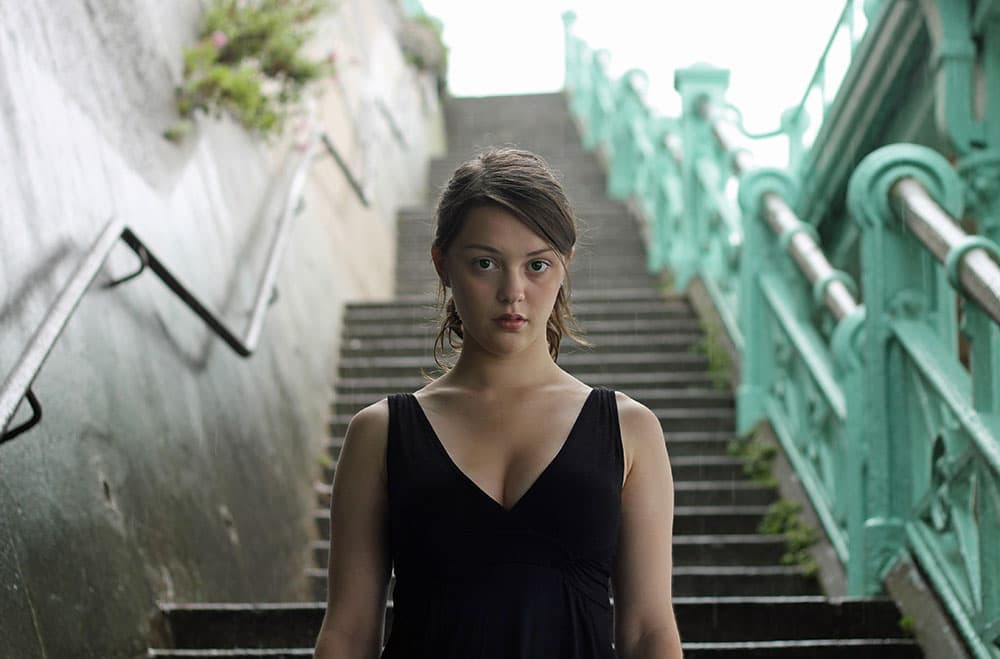
Two diagonal lines draw in the eye to the central point Canon. EOS 550D, 50mm, 1/125sec at f/2.8, ISO 100. Credit: Mark Wilkinson
Mark says:
“Lead-in lines are a great way to create a strong image. I have always naturally included them in my photography, but it’s only in recent years that I have started to analyse my images and realise how they can be pushed even further to create a really effective composition. A lead-in line draws the viewer’s eye down the line to a point in the image. By placing a subject on this point, it helps to create a strong and impactful image. Stairwells and bannisters are a great way of using this compositional device, particularly as you can be higher than a model to use the added advantage of height to make the model’s eyes even stronger.”
Imogen says:
“Working with lead-in lines on a shoot helps me as the model to work out how the image is being composed and to change my posing accordingly.”
Top tip
You can use the principle of lead-in lines even if you don’t have a strong architectural line to work with. Try using the model’s arms or legs in a diagonal angle to draw the eye into the model in a natural, subtler way.
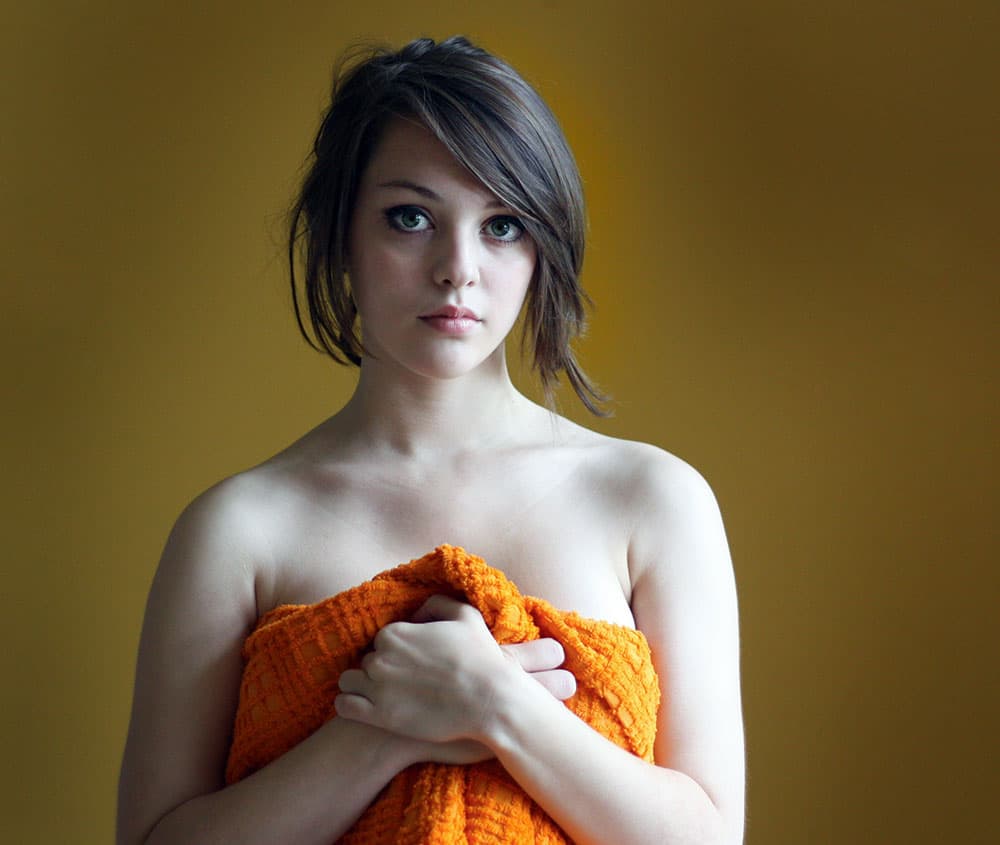
Use the background to incorporate your chosen colour. Canon EOS 4500, 50mm, 1/320sec at f/1.8, ISO 100. Credit: Mark Wilkinson
Colour matching
Colour matching is a simple and effective way to create a cohesive image and is something Mark and Imogen have been experimenting with since they first started working together. It requires some thought and planning, but it can make the difference between a good shot and a fantastic shot. In order to match colours well, you need to know where you are shooting and how you are going to incorporate the colours. The basic principle is to match three different shades of the same colour in an image – this can be done with clothing, props, accessories and the background. Although three shades create a cohesive look, a well-thought-out image can also be made with two matching colours in an image.
Imogen says:
“During our time shooting together we’ve found that colour matching can be really subtle – a flash of red on a street sign, a small hair clip and a bright red lip can all work beautifully together to really elevate a portrait. It’s always easier to use plain clothing rather than patterns, as it’s easier to match with things you find when you’re out and about shooting on location. Mark also has some different coloured scarves and hair clips that he always carries in his bag, which he can pull out to help tie together an image quickly and easily. If bright colours aren’t right for your shoot, you can also monochrome match for a strong effect. I enjoy colour matching, as it can be a collaborative part of setting up the image. Where Mark will often spot colours in the background of the photograph and plan outfits and accessories, I’ll often suggest colours that can be drawn in with my make up.”

Colour matching, such as the green colours in this picture, can really elevate a portrait Canon EOS 450D, 50mm, 1/125sec at f/2.8, ISO 400. Credit: Mark Wilkinson
Top tip
Use the model’s eye colour as the inspiration for your colour-matched image. For example, in the image above, green clothing, accessories and props have been used to match with Imogen’s eye colour. In post-processing, the colour of the eyes was enhanced to strengthen the natural pop of green.
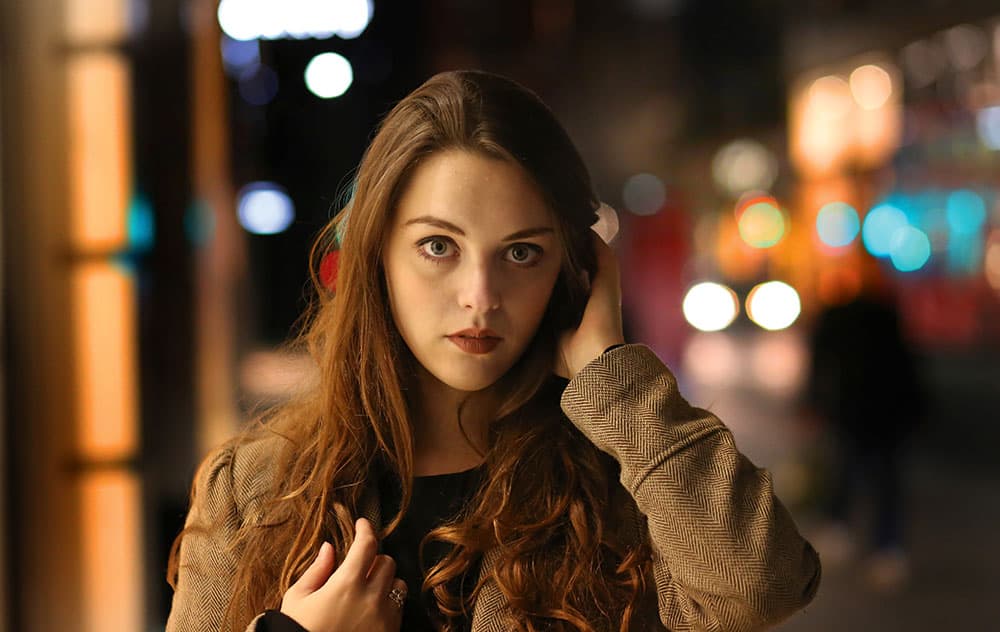
When shooting in low light, it is helpful to keep posing very simple. Canon EOS 6D, 85mm, 1/200sec at f/2.5, ISO 4000. Credit: Mark Wilkinson
Night photography
It is often easy to feel as if photo shoots need to end as the light dips at the end of the day. However, you can still take beautiful photos at night-time. Cameras today are designed better than ever before to handle low-light situations with relative ease. Head into town as the light begins to drop and make use of the light from cars, lamps and shop windows. For example, placing your model by a shop window and turning their face slightly towards the light means you can still shoot a well-lit portrait at night. Or you could try to place the model so that he/she is completely facing the light, for a flatter and more even light.
Keep posing very simple. The smallest movement to the angle of your model’s face can change the look without adding too many focus complications. By bringing the hands up to the face you can add extra interest into your images.
Night photography looks particularly magical when using a shallow depth of field. The bokeh in the background will make car and street lamps blur into beautiful coloured orbs of light. Using a fast lens is ideal for creating this effect. You can also add colour to manipulate mood. For example, a blue light can be used to suggest a melancholy feel. When working in low light, increasing the ISO and decreasing the shutter speed will also help to utilise as much of the ambient light as possible. However, this can make focusing and achieving a sharp image much more challenging. If possible, use a tripod if it’s not too intrusive at your location. Failing that, ledges and surfaces naturally available within your surroundings can also be used to steady the camera.
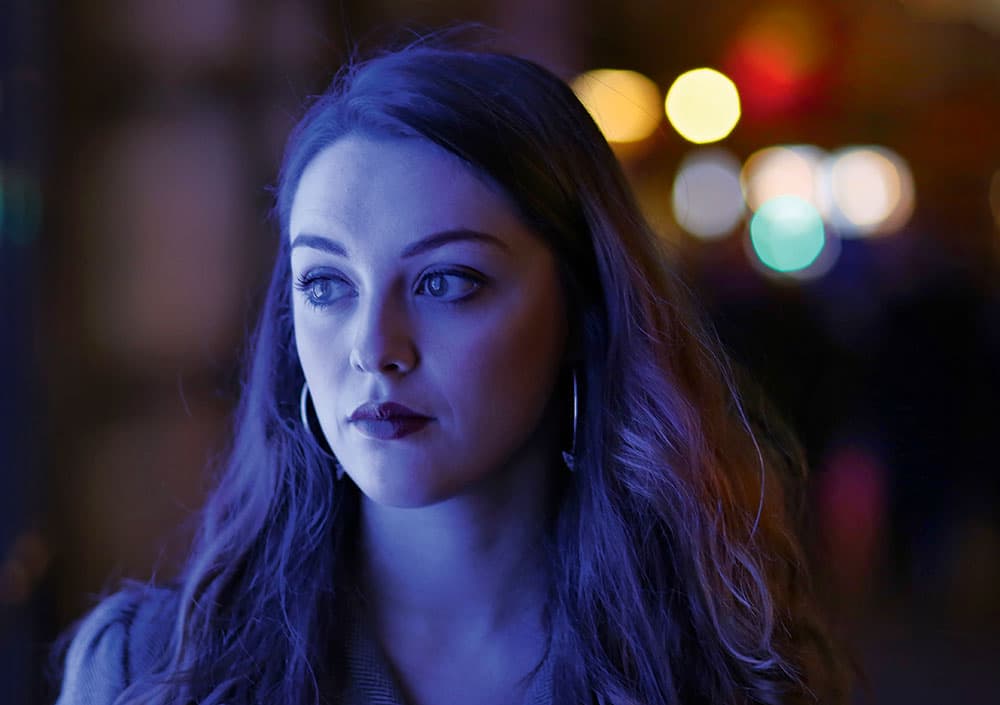
Shop fronts often provide different colours and hues of light Canon EOS 6D, 85mm, 1/125sec at f/2.2, ISO 1250. Credit: Mark Wilkinson
Mark says:
“Night photography is something I have come to late on in my photographic journey of 40 years. Shooting at night is a fantastic way of getting atmospheric photographs, and you only need simple kit and some confidence. Recently, we have started running night photography workshops, and they have quickly become some of the most popular workshops we run. As the light is often changing quickly, you get real energy from having to constantly adapt and reassess your surroundings.”
Imogen says:
“From my perspective, the flexibility and creativity of night photography is something I really enjoy. Having to adapt quickly to the changing light and watching the photographer work is really inspiring and helps me to be creative with my own modelling.”

Place the model to the side of a shop front to capture a well-lit portrait Canon EOS 550D, 50mm, 1/100sec at f/2.5, ISO 400. Credit: Mark Wilkinson
Top tip
Pack a small handheld light to help illuminate any areas of the model’s face that need some extra light.
Imogen Dyer
Imogen has combined her passion for modelling, education and the arts to co-found the hit YouTube channel WeeklyImogen, where she presents videos and provides tips on how to work effectively with models.
Mark Wilkinson
Mark is a fine-art specialist and portrait photographer. He has worked with Imogen since 2009, and many of their images can be seen on his Flickr account, unexpectedtales, and their YouTube channel, WeeklyImogen.

